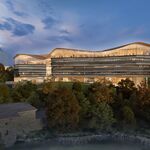Much-anticipated downtown task force report lays out blueprint for action in the core

- January 11, 2024
- 3:43 PM
- ET

- Organizations: Downtown Ottawa Revitalization Task Force
- People: Ariel Troster, Graeme Hussey, Yasir Naqvi
“The purpose has been to highlight the challenges facing our downtown core … and bring together all different perspectives – workplace, business, tourism, and community – to make sure that those ideas are shared and to solicit ideas from the community as well.”
On Thursday, the task force released the long-anticipated report, which includes recommendations to breathe new life into the city’s struggling downtown, after several months of delay.
At a media event Thursday, Naqvi called the report “comprehensive,” adding that it brought together ideas and suggestions from over 1,000 contributors across multiple sectors.
Some of the challenges explored include: lack of affordable housing; chronic homelessness; reinvigorating local businesses in a hybrid work environment; encouraging the return of residents and tourists; creating a sustainable urban environment; and creating inclusive community spaces that promote Indigenous reconciliation.
Originally struck in 2022 by Naqvi, the task force has spent the months since holding meetings with members, as well as conducting surveys and consultations with experts, government representatives, and community stakeholders.
“The purpose of the task force from day one has been to prioritize Ottawa’s downtown core,” he said Thursday. “The last few years have witnessed profound shifts in the city, with remote work becoming the norm and our once bustling city centre suffering the brunt of it. But in every crisis, there lies an opportunity for transformation.”
Co-chair Graeme Hussey, president of Cahdco, said revitalizing the downtown core is key to ensure success for all of Ottawa.
“I was personally motivated to get involved by the firm belief that our downtown is a vital part of the city and we need a vital downtown to have a successful city,” he said. “Downtown is where some 20 per cent of property tax revenues derive from. We have over 11 million visitors each year as tourists, and it generates over $2.2 billion in annual tourism revenue.”
He added that downtown is “where some of our most vulnerable citizens reside and find the resources they need to support themselves. Helping them has to be addressed urgently, as the city is seeing an increasing and expanding need for shelters, affordable housing, mental health supports, drug consumption services, and access to food and meals.”
The report is presented in five parts, first outlining the context and explaining the approach, then examining examples of areas where change is viable.
The third section identifies three buildings as potential “transformative projects” that it recommends exploring for revitalization: The Jackson Building, the old Ottawa Public Library, and l’Esplanade Laurier.
The last two sections list short-, medium- and long-term priorities for downtown, and call for participation from leadership, including all three levels of government.
Naqvi conceded that most of the recommendations could take years to bring to life, especially when they require collaboration between multiple levels of government and leaders across multiple sectors.
The most immediate actions that align with the task force’s recommendations will come from ongoing initiatives at the city level, which were in motion before the report’s release.
Somerset Coun. Ariel Troster said upcoming projects that residents are already starting to see include a new non-police crisis response system, shelters retrofitted with bunk beds to increase capacities, and incentives for office-to-residential conversions.
“(I’m) very happy with this partnership,” she said. “Certainly can’t do it alone, but there are many things the city is doing right now.”
Naqvi said the process of implementing the recommendations will be a long and complicated one.
“There’s no one fix that’s going to revitalize downtown,” he said. “There are many levers that are available to us that need to be worked on simultaneously so we not only achieve outcomes in the short term, but then also accomplish long-term solutions that will allow for a sustainable revitalization of downtown.”
The release of the report comes after months of delays, with the deadline initially slated for late spring 2023. When that deadline passed, a new date was set tentatively for mid-August. The report finally received “tentative approval” from members in October.
Naqvi said the delay came from the complexity of the issues and the diversity of ideas proposed from contributors.
“What we wanted to do was start this conversation,” he said. “Up to now, nobody had done this work to compile all these things together and highlight the different challenges and really put them in context.”
According to Naqvi, the report is just the first step for the task force, which will continue its work by focusing on ways to begin implementing its recommendations. That means getting all three levels of government and local stakeholders across multiple sectors to buy into their proposed strategies.
“I think the next task for us is to start implementing,” he said. “To work with those different partners and find ways as to how we can put those short-, medium-, and long-term ideas into action. That will require work and a lot of discipline.”
In the short term, the report proposes reducing municipal and federal fees for small and mid-size businesses over the next three years, including garbage removal, outside patio, and cultural activities fees. It also recommends encouraging temporary and short-term uses for public spaces by businesses.
Medium- and long-term recommendations for business include:
- Reviewing municipal and federal business-to-business services to reduce delays
- Establishing a pilot program to incentivize activities, temporary uses, policies and infrastructure
- Creating a program to identify and apply sources of funding for small and mid-size businesses
- Developing a science and technology innovation hub strategy for downtown with universities, colleges and the private sector
- Incentivizing research and academic institutions to establish a satellite presence downtown focused on innovation and supported by an entrepreneurship program
- Supporting growth of public- and private-sector employment
- Establishing an integrated business and economic develop delivery areas for downtown through the BIAs and the Ottawa Board of Trade

Much-anticipated downtown task force report lays out blueprint for action in the core – Ottawa Business Journal
There's no one fix for Ottawa’s downtown core, but a new report by the Downtown Ottawa Revitalization Task Force aims to be the first step in the process.










